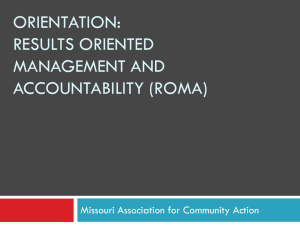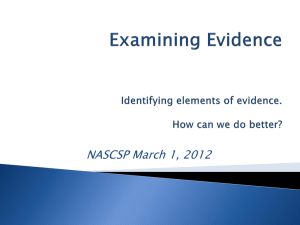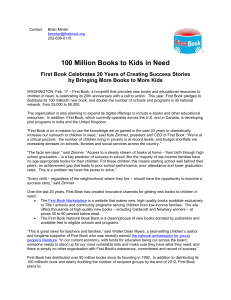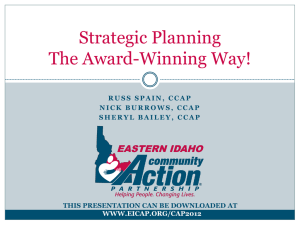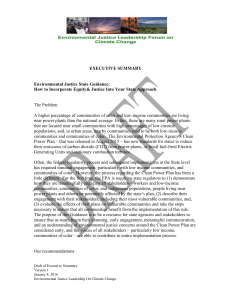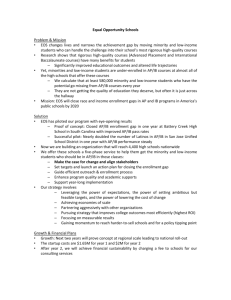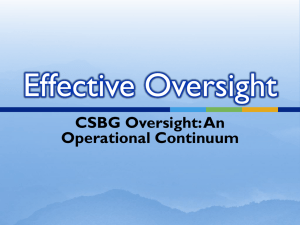Strategic Planning Nuts and Bolts: The Basic Elements of
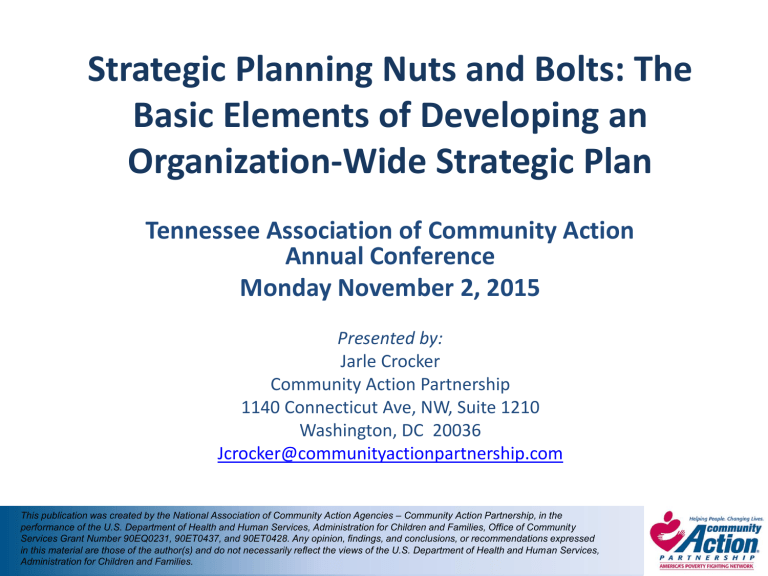
Strategic Planning Nuts and Bolts: The
Basic Elements of Developing an
Organization-Wide Strategic Plan
Tennessee Association of Community Action
Annual Conference
Monday November 2, 2015
Presented by:
Jarle Crocker
Community Action Partnership
1140 Connecticut Ave, NW, Suite 1210
Washington, DC 20036
Jcrocker@communityactionpartnership.com
This publication was created by the National Association of Community Action Agencies – Community Action Partnership, in the performance of the U.S. Department of Health and Human Services, Administration for Children and Families, Office of Community
Services Grant Number 90EQ0231, 90ET0437, and 90ET0428. Any opinion, findings, and conclusions, or recommendations expressed in this material are those of the author(s) and do not necessarily reflect the views of the U.S. Department of Health and Human Services,
Administration for Children and Families.
“Leadership is the capacity to translate vision into reality.”
— Warren Bennis
Strategic Planning Discussion Frame
• What is strategic planning and how is it used by Community Action Agencies?
• What are the stages and activities of the typical strategic planning process?
• What questions do you have?
• What challenges and successes can you share with your peers?
Characteristics of Strategic Planning
• Board-driven, staff engaged
• Sets long-term goals that are targeted, specific, and achievable
• Driven by data
• Forces choice based on strategic needs, competing resources, and time
• Aims to increase integration and efficiency in management and operations
• Builds on and leverages relationships with internal and external stakeholders
• Seeks to improve outcomes through change and innovation
Strategic Planning in Context
Community
Assessment
Strategic
Planning
Community
Action Plan
CAA Boards (IM 82)
Sections 676B of the Community Services Block Grant
Reauthorization Act of 1998 requires that, as a condition of designation, private nonprofit entities and public organizations administer their CSBG program through tripartite boards that “ fully participate in the development, planning, implementation, and evaluation of the program to serve low-income communities .”
6
CSBG Network Factors Affecting
Strategic Planning
• Lack of local and national network visibility
• Need for clear local and national policy agendas
• Shift to integrated service delivery models – two generation, bundled, and place-based services
• Increased focus on outcomes – data collection, planning processes, and awareness/education
Six Stages of Strategic Planning:
A ROMA and Theory of Change Model
ROMA Planning Cycle
Incorporating the Theory of Change
Theory of Change
• What is the connection between strategic planning and the theory of change?
• How do we incorporate it into the strategic planning process?
Back to main
Incorporating the Theory of Change
Needs
Assessment
Community
Action Plan
Theory of
Change
Strategic
Plan
1. Preparation
• Clarify roles of the ED, board, and staff
• Choose when to begin
• Create the initiating committee
Planning to Plan
Back to main
Strategic Planning Roles
Board
• Provide input on agency’s strategic direction
• Assist with process design and research
• Identify resources to support process
Executive Director
• Initiate discussion on purpose and timing
• Ensure adequate resources
• Oversee process design and research
• Engage key internal and external stakeholders
Staff
• Manage initiating committee
• Develop research plan and conduct research
• Develop strategic planning process
• Manage communications
• Manage logistics
Factors Affecting Timing
• Needs assessment
• Fiscal year or other financial schedules
• Leadership transitions
• Organizational events (e.g. conferences)
• Availability of time and resources
• Monitoring schedule
Questions About Readiness
• Why are we planning and what do we hope to achieve?
• Does the agency face any strategic choices?
• Are we achieving our vision, aligned with our mission, and cultivating a healthy organizational culture?
• Is the agency financially sound and sustainable?
• Do we have adequate human capital, technological capacity, and physical infrastructure?
• Is the board sound, engaged, and effective?
Organizing the Initiating Committee
Membership
• Representation from board
(strategic planning committee)
• Executive Director
• Leadership team
• Program managers
• Administrative support
• Other stakeholders: line staff, customers, key partners
Roles
• Design strategic planning process
• Design and conduct research process
• Provide logistical support
• Manage communication with internal and external stakeholders
2. Assessment
• Develop research plan
• Review of vision, mission, values
• Scan of internal and external stakeholders
Conduct Research
Back to main
Develop a Research Plan
• Identify what data we already have (e.g. needs assessment)
• What data do we need?
• Which stakeholders do we need to engage?
• What methods will we use?
• How will we organize and report the data?
Questions for Mission/Vision Review
• What needs and opportunities are there to fill?
• Who are our primary customers?
• Who are our primary partners?
• What are our service delivery strategies?
• What goals do we want to achieve for families, the community, and organizations?
• What is our core business and primary services?
• What is our theory of change?
Identify Stakeholders
Internal
• Board
• Leadership team
• Human resources
• Finance/budget
• Facilities
• Program managers
• Front line staff
External
• Customers
• Key partners
• Funders
• State CSBG Lead Agency
• Nonprofit service providers
• Public agencies
• School system
• Private sector
• Faith community
• Grassroots/advocacy
Choose Research Methods
• Key informant interviews
• Focus groups
• Surveys
• Community forums
• Archival research
Focus Research by Stakeholder Group
Stakeholder Group
Customers
Front line workers
Program managers
HR and Finance
Board
Eternal partners
Research Focus
Satisfaction with services, community needs
Organizational climate, job satisfaction
Service delivery strategies and outcomes, community needs
Organizational capacity
Strategic direction
Strategic direction, service delivery strategies
Four Key Program Questions for
Strategic Planning
• Where are we providing services but not achieving good outcomes? (Where do we need to do better?)
• Where are we providing services but not meeting family and community needs? (Where do we need to do more?)
• Where are there gaps in services and/or needs for different types of services? (Where do we need new services?)
• How effective is our overall anti-poverty agenda?
--Network of stakeholder relationships
--Awareness of the broader community
--Strength of a policy/systems change agenda
Research Frameworks
SWOT
• Strengths
• Weaknesses
• Opportunities
• Threats
Dual Bottom Line
• Mission impact
• Financial impact
Strategy Map: What to Include?
• Social
• Political
• Economic
Environment
Agency Inputs
• Financial Capital
• Human Capital
• Social Capital
• Staff
• IT/data
• Facilities
• Board
Agency
Capacity
Strategy Map: What to Include?
• Public sector
• Nonprofit sector
• Private sector
• Community organizations
Partnerships
Outputs
• Programs and services
• Community engagement
• Education and advocacy
• Individuals and families
• Organizations
• Community
Customers/Needs
Data Collection: Matrix Map
• Do you know which program areas have a financial benefit and those which loose the agency money?
• Do you know which programs have a large mission impact and those that are less impactful?
Sustainability
• Nonprofit Sustainability: Making Strategic
Decisions for Financial Viability (2010)
– Jeanne Bell, Jan Masaoka, Steve Zimmerman
– Fiscal Oversight combined with programmatic oversight
– www.josseybass.com
Matrix Map Analysis
Decision
Making
The Sustainable
Nonprofit
Business Model
A Duel Bottom Line: Mission Impact and Financial Return
High Mission
Impact
Low
Profitability
High Mission
Impact
High
Profitability
Low Mission
Impact
Low
Profitability
Low Mission
Impact
High
Profitability
From: Nonprofit Sustainability: Making Strategic Decisions for
Financial Viability (2010)
The Sustainability Mindset
3. Planning
• Design plan development process
• Develop the plan
• Finalize the plan
Create the Plan
Back to main
Process Design Options
• Committee and task groups
• “Open space” large group meeting
• Team-based negotiation
• Retreat with small group
Types of Planning
• Strategic Planning: Provides Guidance in fulfilling a mission with maximum efficiency and impact
– Goals, Action Steps, Resources, 3-5 years
• Operating Plan: Coordinated set of tasks for carrying out the goals delineated in the strategic plan
– Time frames, roles, 1 year
• Business Plan: Focused on the actions and investment necessary to generate income from a specific program or service
– Product, Competitive Environment, Revenue Assumptions
• Case Statement: Geared toward marketing and fundraising rather than planning
– Goals, Capabilities, Strengths, and Benefits it provides
Source: TCC Group Briefing Paper: Ten Keys to Successful Strategic Planning for
Nonprofit and Foundation Leaders
Incorporating the Six National Goals
Goal 1. Low-income people become more self-sufficient. (Family)
Goal 2 . The conditions in which low-income people live are improved.
(Community)
Goal 3. Low-income people own a stake in their community. (Community)
Goal 4. Partnerships among supporters and providers of services to low-income people are achieved.
(Agency)
Goal 5. Agencies increase their capacity to achieve results. (Agency)
Goal 6 . Low-income people, especially vulnerable populations, achieve their potential by strengthening family and other supportive systems. (Family)
Incorporating the Six National Goals
• Standard 6.2 requires that strategic plans address one or more of goals that seek: reduction of poverty, revitalization of low-income communities, and/or empowerment of people with low incomes to become more self sufficient
• Some CAAs use the Six National Goals as their broad strategic goals
• Some have the plan roll up into to the six goals operationally but not directly as part of their plan
• Some key into Family, Agency, and Community as the overlay for their plan
• No one right way to do it, but good to have the Six National
Goals considered
Incorporating ROMA Target Goals
Standard 6.3 requires that strategic plans include one or more of:
• Family goals
• Agency goals
• Community goals
Organizing the Plan’s Structure
A. Programs, Services, and Activities
B. Communications and Marketing
C. Partnerships/Collaborations
D. Governance
E. Facilities
F. Fund Development
G. Human Resources
H. Information Systems and
Technology, etc.
Goals, Objectives, Steps
Goal Improve job satisfaction of front line staff
Objective Increase pay Develop career advancement ladder
Actions -Study other models for pay scales
-Review budget options
-Identify fee for service opportunities
-HR will develop new steps
-Review training needs
-Draft professional development plan for each position
Finalizing the Plan
• Ensure all goals have timelines, resource requirements, and assigned responsibilities
• Initiating Committee gathers any additional information and feedback
• Initial draft is completed and circulated to stakeholders for review
• Final draft is completed and submitted to board for approval
• Implementation committee
(or similar structure) is created
4. Implementation
• Convene implementation committee
• Develop operational plans
• Develop monitoring and reporting plan
Acting on the Plan
Back to main
Structure and Roles of the
Implementation Committee
Structure
• Single committee
• “Handoff” to leadership team
• Task groups organized by strategic plan goals
• Integrate into program or department work plans
Roles
• Develop operational plans
• Review budget and resource needs
• Regular meetings to review progress (at least quarterly)
• Report to leadership team and board
• Identify and address implementation challenges
Integrating the Strategic Plan into
Management and Operations
• Quarterly or Annual report to the board
• Monthly or quarterly updates to the leadership team
• Monthly meetings by the implementation team to oversee progress on individual goals
• Creation of task committees to manage individual goals
• Integration into or development of an agency-wide or balanced scorecard to track progress
• Make strategic plan goals part of formal job descriptions
• Updates on strategic plan progress at staff meetings
Balanced Scorecard Toolkit
This publication was created by the National Association of Community Action Agencies – Community Action Partnership, in the performance of the U.S. Department of Health and Human Services, Administration for Children and Families, Office of Community Services Grant Number 90ET0428. Any opinion, findings, and conclusions, or recommendations expressed in this material are those of the author(s) and do not necessarily reflect the views of the U.S. Department of Health and Human Services,
Administration for Children and Families. The publication is provided free of charge to CSBG grantees and is part of the National T/TA Strategy for Promoting Exemplary
Practices and Risk Mitigation for the CSBG program. To download the report, please visit www.communityactionpartnership.com.
Top Ten Tenets to Create a Balanced
Scorecard
1.
Gain top leadership support; it helps if there is a 'burning platform' for change.
2.
Measure the right things - things that customers, stakeholders, and employees find value in -- not everything.
3.
Create a governance process that engages key stakeholders.
4.
Design the system to follow the actual work of the organization.
5.
Start development of measures at both the top and bottom of the organization and cascade them in both directions.
6.
Create a communications campaign that explains how a Scorecard both reflects and drives a focus on mission.
7.
Align systems: tie them to the organization's planning, measurement, and budget cycles.
8.
Insure the credibility of the process and honesty in reporting.
9.
Create transparency of information that is as real-time as possible; this is key to its credibility and usefulness to both senior and frontline managers.
10. Align incentives: link rewards to performance through effective evaluation and performance appraisals.
5. Results
• Track results of strategic plan goals
• Conduct updates to strategic plan goals and work plans as necessary
Monitor the Plan
Back to main
Monitoring the Strategic Plan
• Convene six month or annual review of strategic plan goals
• Continue monthly or quarterly reporting of plan outcomes through an agency-wide scorecard, the implementation committee, or similar structure and process
• Provide time for board discussion and feedback
Evaluation
• Evaluate outcomes
• Update strategic plan and operational plans
• Connect strategic plan outcomes to upcoming community assessment
Assess the Impact
Back to main
Potential Challenges
• Unclear or unassigned leadership roles
• Disengaged board
• Inconsistent follow-through
• Decision-avoidance
• Lack of a willingness to change
• Budget decisions get delayed, and delayed, and delayed….
• Unclear expectations of staff and board members
• Time frame keeps extending…the never ending strategic plan….
• It gets done and sits on a shelf gathering dust
Vision and Direction
Strategic Planning
• Standard 6.1 • private
The Organization has an agency-wide Strategic Plan in place that has been approved by the governing board within the past 5 years .
• Standard 6.1 • public
The Department has a Strategic Plan, or comparable planning document, in place that has been reviewed and accepted by the tripartite board/advisory body within the past 5 years . If the Department does not have a plan, the tripartite board/advisory body will develop the plan.
Vision and Direction
Strategic Planning
• Standard 6.2 • private
The approved Strategic Plan addresses reduction of poverty, revitalization of low-income communities, and/or empowerment of people with low incomes to become more self-sufficient.
• Standard 6.2 • public
The approved Strategic Plan, or comparable planning document, addresses reduction of poverty, revitalization of low-income communities, and/or empowerment of people with low incomes to become more self-sufficient.
Vision and Direction
Strategic Planning
• Standard 6.3 • private
The approved Strategic Plan contains Family, Agency, and/or
Community goals.
• Standard 6.3 • public
The approved Strategic Plan, or comparable planning document, contains Family, Agency, and/or Community goals.
Vision and Direction
Strategic Planning
• Standard 6.4 • private
Customer satisfaction data and customer input , collected as part of the Community Assessment, is included in the strategic planning process.
• Standard 6.4 • public
Customer satisfaction data and customer input , collected as part of the Community Assessment, is included in the strategic planning process, or comparable planning process.
Vision and Direction
Strategic Planning
• Standard 6.5 • private
The governing board has received an update(s ) on meeting the goals of the Strategic Plan within the past 12 months .
• Standard 6.5 • public
The tripartite board/advisory body has received an update(s ) on meeting the goals of the Strategic Plan/Comparable
Planning Document within the past 12 months .
Organizational Standards
Other Related Ares
• Standard 1.3 • private
The organization has a systematic approach for collecting, analyzing, and reporting customer satisfaction data to the governing board.
• Standard 1.3 • public
The department has a systematic approach for collecting, analyzing, and reporting customer satisfaction data to the tripartite board/advisory body, which may be met through broader local government processes.
Organizational Standards
Other Related Areas
• Standard 4.1 • private
The governing board has reviewed the Organization’s mission statement within the past 5 years and assured that:
1. The mission addresses poverty; and
2. The Organization’s programs and services are in alignment with the mission.
• Standard 4.1 • public
The tripartite board/advisory body has reviewed the Department’s mission statement within the past 5 years and assured that:
1. The mission addresses poverty; and
2. The CSBG programs and services are in alignment with the mission.
Organizational Standards
Other Related Areas
• Standard 4.3 • private
The Organization’s Community Action Plan and Strategic Plan document the continuous use of the full ROMA cycle or comparable system (assessment, planning, implementation, achievement of results, and evaluation). In addition, the Organization documents having used the services of a ROMAcertified trainer (or equivalent) to assist in implementation.
• Standard 4.3 • public
The department’s Community Action plan and strategic plan document the continuous use of the full Results Oriented Management and Accountability
(ROMA) cycle or comparable system (assessment, planning, implementation, achievement of results, and evaluation). In addition, the department documents having used the services of a ROMA-certified trainer (or equivalent) to assist in implementation.
Organizational Standards
Other Related Areas
• Standard 9.3 • private
The organization has presented to the governing board for review or action, at least within the past 12 months, an analysis of the agency’s outcomes and any operational or strategic program adjustments and improvements identified as necessary.
• Standard 9.3 • public
The department has presented to the tripartite board/advisory body for review or action, at least within the past 12 months, an analysis of the agency’s outcomes and any operational or strategic program adjustments and improvements identified as necessary
Toolkit Coming from Illinois
Community Action Examples
Community Action Examples
www.communityactionpartnership.com
CSBG T/TA Resource Center
• www.csbgtta.org
• Many more toolkits, webinars, and print resources
• Consultant Bank
• Training Calendar
• Discussion Forum
• Shared Calendar
• Individual registrations for Board and Staff
Pathways to Excellence: The Network’s
Premier Capacity Building Initiative
Getting Started at Getting Better – the process starts where you are today
Diagnostic process using 35 National CAA
Standards in a guided Self-Study Process
Feedback reports identify Strengths and
Opportunities for Improvement
The Pathways Process
2 day Self-Study training for your Pathways team
9 months to complete the Self-Study, with
Partnership Technical Assistance monthly by
Web Meeting
3 months for the expert peer review and
Feedback Report process
Questions?
Contact
Jarle Crocker, PhD
202-449-9774 jcrocker@communityactionpartnership.com
Thank you!
Many of the publications , training, and webinars mentioned were created by the National Association of Community Action Agencies – Community Action Partnership, in the performance of the U.S. Department of
Health and Human Services, Administration for Children and Families, Office of Community Services Grant Number 90ET0428, 90EQ0231, 90ET0434, 90ET0436, 90ET0437, and 90ET0445. Others were created by the Community Action Program Legal Services, Inc. (CAPLAW), in the performance of the U.S. Department of Health and Human Services, Administration for Children and Families, Office of Community
Services Grant Number 90ET0429 and 90SQ0047. Any opinion, findings, and conclusions, or recommendations expressed in this material are those of the author(s) and do not necessarily reflect the views of the
U.S. Department of Health and Human Services, Administration for Children and Families.
LEAD INNOVATE TRANSFORM
